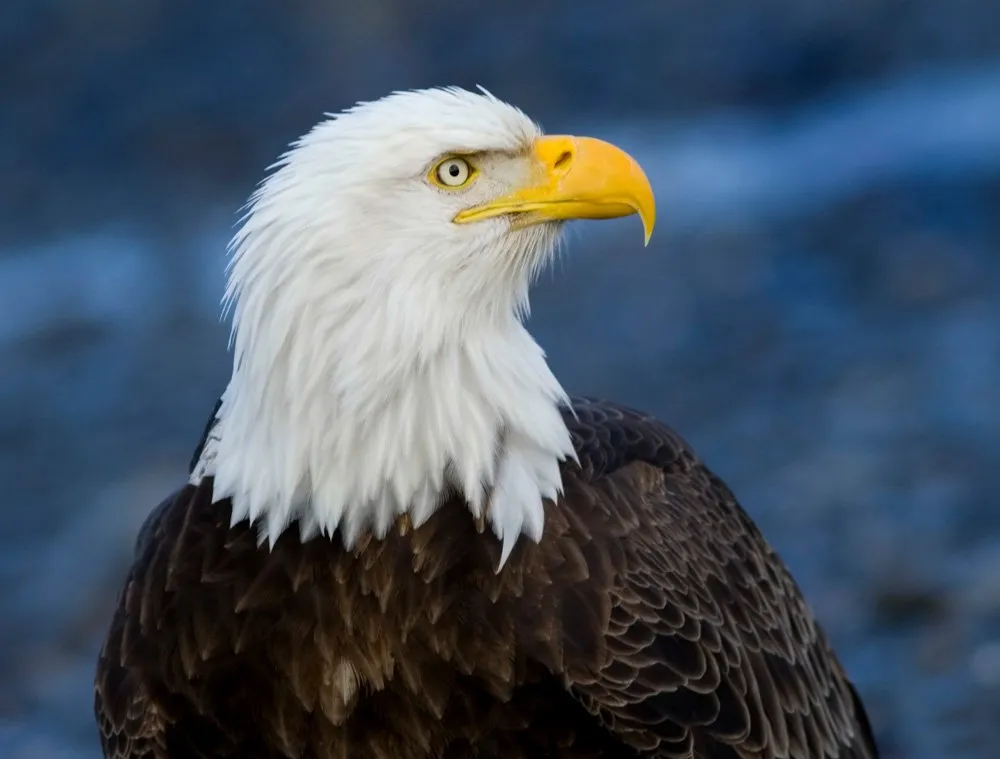Eagles are some of the most stunning birds of prey, recognized for their strength, size, and beauty. Their hunting skills and presence make them symbols of freedom, power, and courage worldwide. In this article, we’ll explore everything about eagles. We’ll cover their description, where they live, their behavior, and their conservation status.
Table of Contents
Scientific Classification
| Kingdom | Animalia |
| Phylum | Chordata |
| Class | Aves |
| Order | Accipitriformes |
| Family | Accipitridae |
| Genus | Aquila (or Haliaeetus, depending on species) |
| Species | Multiple (depending on the specific eagle species) |
| Scientific Name | It varies by species. For example, Aquila chrysaetos (Golden Eagle) and Haliaeetus leucocephalus (Bald Eagle). |
Description
Eagles are large birds of prey that stand out due to their impressive size, sharp talons, and hooked beaks. Depending on the species, their wingspans can range from 5 to 8 feet. They have a strong, muscular build. They can soar high and hunt well. Eagles are known for their great eyesight. It’s much better than humans. They can spot prey from far away. The Bald Eagle is the U.S. national bird. It has a white head and tail, and a bright yellow beak. The Golden Eagle, in contrast, has darker plumage. Its neck has golden-brown feathers. Each eagle species has unique traits. But, they all share some features. They have powerful wings, sharp talons, and a hooked beak. The beak is perfect for tearing apart prey.
Distribution
Eagles live on every continent except Antarctica. They thrive in mountains, forests, coastal cliffs, and grasslands. In North America, the Bald Eagle is commonly seen, especially in the United States and Canada. The Golden Eagle also ranges widely across North America. But, it tends to be found at higher elevations in the west. In Europe, the Golden Eagle is prevalent, while Africa is home to the Tawny Eagle and the African Fish Eagle. Asia features the formidable Steppe Eagle, and Australia boasts the Wedge-tailed Eagle. Their global distribution shows their adaptability to different climates. Most eagles, however, prefer areas near open water, ideal for their fish diet.
Habitat
Eagles live in many habitats. These include coasts, mountains, plains, and forests. They prefer places with lots of open space for hunting. They also like high spots for nesting. You’ll often spot eagles near large bodies of water, like rivers, lakes, and coastlines. They hunt for fish and other aquatic animals there. For instance, the Bald Eagle builds its nest in tall trees near water. The Golden Eagle prefers steep cliffs in mountainous regions. Eagles need large, low-human areas. So, they are seen in remote or protected places.
Diet
Eagles are carnivorous birds of prey. Their diet depends on their environment. Most species primarily hunt other animals, favoring fish, small mammals, and birds. The Bald Eagle, for instance, is especially known for its fish diet. Its powerful talons let it catch fish in rivers and lakes with great precision. Golden Eagles have a more diverse diet. It includes rabbits, hares, and squirrels. It also includes, sometimes, larger animals like foxes or young deer. Their hunting skills are impressive. They often dive at high speeds to catch prey in the air. Eagles are opportunistic hunters. They may scavenge carrion if needed. But, they prefer live prey. They can dive at up to 100 mph. This makes them fierce hunters of any animal within reach.
Behavior
Eagles are usually solitary, except during mating season when they pair up. Eagles are famous for their flight. They excel at soaring for long periods by using thermal updrafts. This lets them glide with little energy. Their strong wings and sharp eyesight make them exceptional hunters. When not hunting, eagles are often seen on high trees or cliffs. They watch for threats or prey. Their call is sharp and is frequently linked to the ideas of wilderness and strength. Eagles are known for their strong territorial nature. They also engage in complex courtship displays. These displays include aerial moves like locking talons and spiraling down together. Eagles are fiercely protective of their nests. They aggressively defend their territory against intruders and other eagles during breeding season.
Lifespan
Eagles are known for their long lifespans, with many species reaching their 20s and even 30s in the wild. The Bald Eagle typically lives 20 to 30 years in the wild. Some can live longer in captivity, where they are safe from predators. In captivity, eagles live longer. They have a steady food supply, medical care, and protection from dangers in the wild. In the wild, their lifespan can be cut short by accidents, diseases, or predators. Eagles age interestingly. Their plumage changes as they get older. Young eagles have brown, mottled feathers. Adult eagles have vibrant, distinct colors.
Reproduction and Lifecycle
Eagles are renowned for their strong family ties and usually mate for life. During the breeding season, they perform complex courtship rituals. These strengthen their bond and attract a mate. Once a pair has bonded, they often return to the same nesting site each year. They make minor repairs and add to their existing nest. Eagles build large nests, called “eyries.” They are in tall trees or on cliffs. These nests can be enormous, sometimes weighing several hundred pounds. Bald Eagles build their nests with large sticks. They line them with softer materials like moss or grass. After a female lays her eggs—1 to 3 each season—both parents take turns incubating them for several weeks. After the eggs hatch, parents feed and protect their chicks. The chicks grow quickly. The young eagles, referred to as eaglets, are fed a diet that includes fish, small mammals, and birds, depending on the species. After several months, the eaglets learn to fly and hunt. They become independent. This process can take up to 6 months, after which the young eagles are ready to venture out on their own.
Predators
As apex predators, adult eagles have few natural threats. But, they aren’t invulnerable. Eagles face threats from other birds of prey. These include rival eagles and larger raptors, like hawks and owls. In rare instances, large mammals such as wolves, bears, and coyotes may prey on young or injured eagles. Eaglets, on the other hand, face risks from various predators. Raccoons, foxes, and even larger birds, like crows, can steal eggs or attack young chicks. These vulnerabilities make eagle nests rare and hard to reach.
Adaptations
Eagles show the power of evolution. They have traits that help them survive. One of their most striking adaptations is their extraordinary eyesight. Eagles can see eight times better than humans. They can spot prey from far away. Their vision is exceptional. It comes from their large, powerful eyes. They have more photoreceptor cells than humans. This helps them notice movement. Additionally, their strong wings and sharp talons are significant adaptations. Eagles have broad, strong wings. They let them fly long distances while hunting or migrating. Their sharp talons grip and catch prey. Their hooked beaks tear into meat easily. Eagles have adapted to climates from frigid North America to the arid Middle East. Their feathers insulate them, keeping them warm in harsh winters. Their lightweight, sturdy bodies let them thrive in warmer areas.
Conservation Status
Eagles have faced threats throughout history. These include hunting, habitat loss, and pollution. In the past, hunting and pesticides like DDT nearly extincted many eagle species. The pesticides weakened their eggshells and harmed reproduction. Take the Bald Eagle, for instance; it was once classified as endangered in the United States. Thanks to conservation efforts, the Bald Eagle population has rebounded. A ban on DDT, protected areas, and hunting limits helped. It was removed from the endangered species list in 2007. Even with these achievements, many eagle species still face risks. Eagle populations worldwide face serious threats. These include habitat destruction, climate change, and illegal hunting. Conservation groups monitor eagle populations and advocate for habitat protection. They want to ensure these magnificent birds thrive for future generations.
Conclusion
Eagles are extraordinary animals, representing strength, elegance, and beauty. Their hunting skills and social traits make them some of the most captivating birds on Earth. Some species have recovered from near extinction. But, we must keep conserving them. It is vital to ensure future generations can see these magnificent birds of prey. Eagles are symbols of power and freedom. Their stunning looks and skills make them beloved by all who see them soar.



